REI
Posted on December 6, 2012 | posted by:
The debate started by Burce Nussbaum seemed to have followed the path of most debates, where a question is posed, only to be attacked by slightly different if not similar ideas where the debate fails to produce efficient results. For a unifying take on the pattern, I believe we must examine the subject, which happens to have gotten quite martial, in light of the martial arts.
The emergence of martial arts is in direct parallel with the history of mankind. Humans are diverse social beings with different cultures, values, rituals and very different takes on the social incidents, regardless of their scale, where in most of which they were forced to defend themselves. People have created systemized physical combat practices in order to survive and protect their values, as well as their lives. These defense disciplines were shaped by specific methods and strategies in regards with human intelligence and as a result of diversity of societies and geographies, such disciplines have taken many forms and were passed on to future generations. The crucial take is that while arriving at the present time, the struggle for survival has taken an artistic dimension in the process.
Today martial arts are practiced by all ages for defense, physical and mental health and spirituality. Even though most of them may seem all blood and thunder, it holds a real value in its core. Martial arts teach its practitioner about patience, forgiveness, respect, sacrifice, humility, hard work and discipline. The underlining statement is so much more than sum of its parts. Some sayings explain:
- “To know peace one must first understand war”
- “To win one hundred victories in one hundred battles is not the highest skill. To subdue the enemy without fighting is the highest skill.”
- You can discover what your enemy fears most by observing the means he uses to frighten you.
I think humanitarian design is a lot like martial arts in its philosophy. It requires humility, discipline and respectful peer to peer collaboration. Especially when our debates involve values and how better to improve such on a global scale, I am of the opinion that we must adhere to the core principles of humanity as defined in the martial arts almost to the philosophical scale. To put it briefly, we must try to understand what has been posed, for it is highly likely that we may be thinking the same thing, only from slightly different perspectives.
Niti Bhan, in her response to the debate “is humanitarian design is the new imperialism? advocates a humble response and states how the core concepts of humanitarian design is not acknowledged with the following issues:
1. A sense of mutual respect – which in turn leads to the perception of arrogance and patronizing good works
2. No sense of give and take – that you may have something to learn from us
3. Lack of awareness of the global political realities or ignorance of history – that your average Indian, Chinese, Filipino or even Finnish designer is far more politically aware and thus doesn’t see you simply as a designer but as an American designer (or British or white or whatever etc), with all the political ideology and history that your nationality entails. This will and does influence their receptivity to your idealistic rhetoric so it behooves you in turn to be aware of the history and politics and perhaps tread a humbler, more respectful path?”
People would defend their values when threatened. And when a solution is proposed from a perspective that had not experienced a local culture as much as its inhabitants, it is quite natural that such solution may be met with hostility. As designers it is our role not to be force solutions but to create them “inside”, and let our design shape and take a condition where it would seem more “familiar” to the recipients of the design. The difference between traditional design approach and humanitarian design is that it shifts the control and uses its power to empower the ones with less, not the use resources that with less power offer for the other way around. Because at the end of the day, on a smaller scale “Global South” has more to offer to “Global North”, however “Global North” holds the key for a solution on the larger scale. So its supposed to be a mutual exchange of resource and knowledge for a better future.
